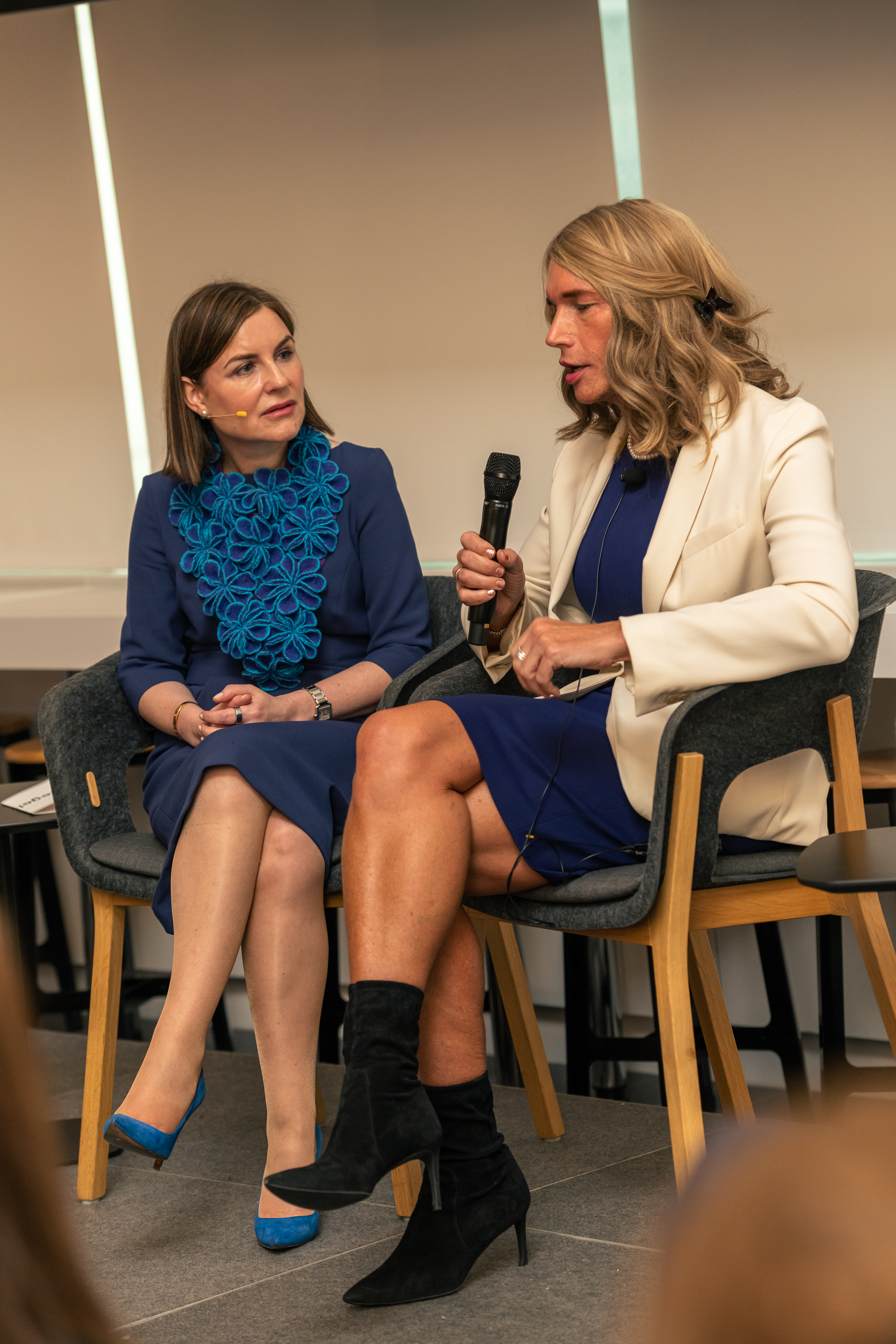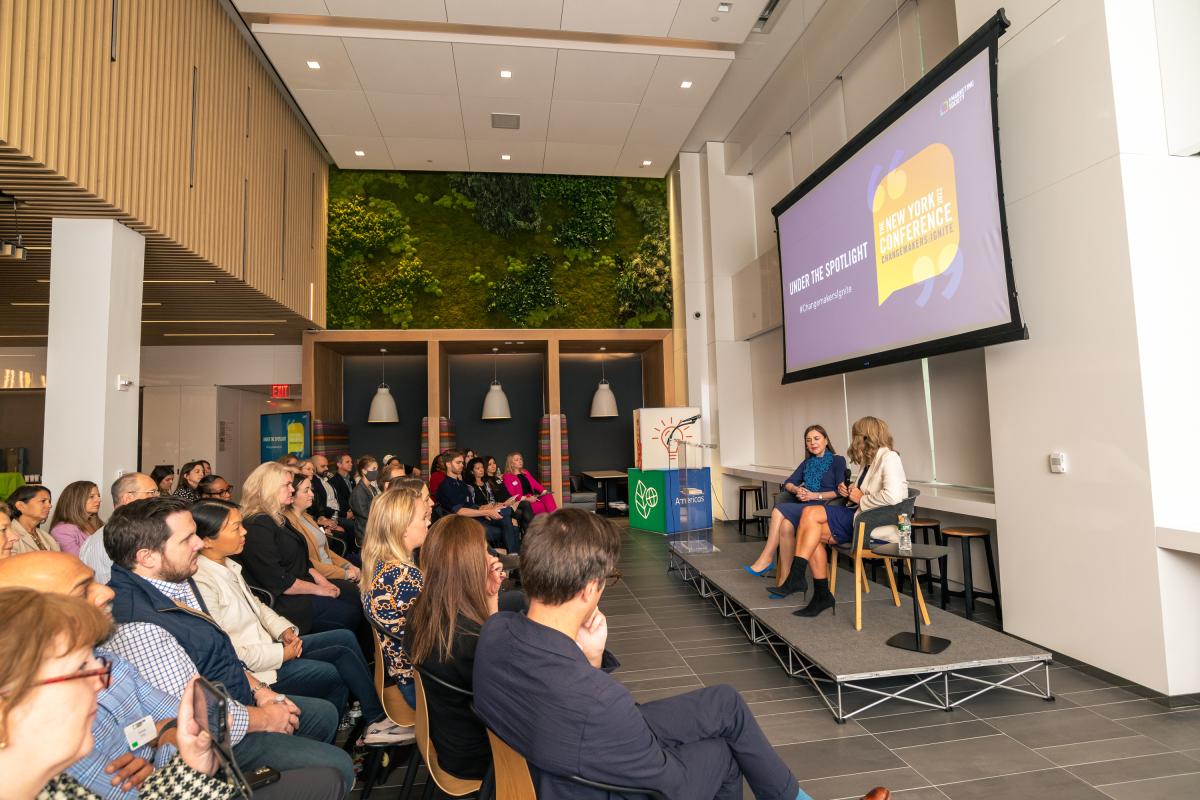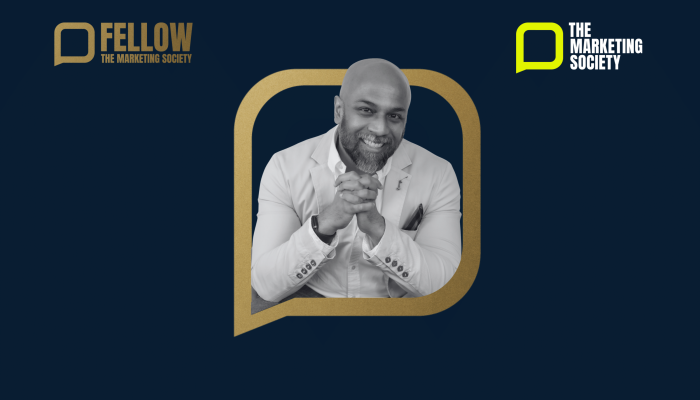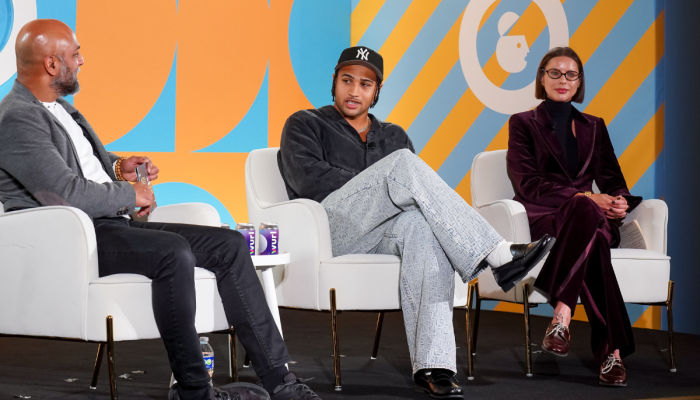I recently led an “Under the Spotlight” conversation on inclusion at The Marketing Society New York Changemakers conference.
The characteristics of changemakers are plentiful and powerful, evoking such words as brave, empowering, and pioneering. My guest, Maeve DuVally, embodies all these traits—and many more. The former Managing Director of Corporate Communications at Goldman Sachs, Maeve, a transgender woman, is pursuing her new calling: serving as a DE&I consultant who advocates fiercely for the LGBTQ+ community and, more broadly, all underrepresented groups.
Maeve opened up about her journey to Maeve, the lessons learned on that journey, and how we can all create inclusive environments. I’m sharing our conversation, which has been edited for clarity and brevity.
 Tell me about when you first realized you were transgender.
Tell me about when you first realized you were transgender.
My story is a little bit different than a lot of transgender people. You’ll hear stories about transgender people that had an inkling that they were transgender from the time they were young—there was just something wrong that they sensed. I sensed there was something wrong, but I didn’t really think it had anything to do with being transgender. I just thought it was generally wrong.
Almost four years ago to the day, I was getting ready to go to a fundraiser here in New York City. And, out of the blue, I had this thought: “I want to wear makeup to this event.” So, I wore makeup to that event. I’m a very rational person—I'm not very rash at all—and this thought just really threw me. So, for the next week, every time it popped up, I challenged it. But every time I challenged it, it came back stronger. But by the end of the week, I concluded that I wanted to be a woman all my life. And I accepted that.
I came out almost immediately in my social life. But the reason you don’t come out is because you’re worried about acceptance. And acceptance is everything—not just for people in underrepresented groups, but everyone wants to be accepted. For whatever reason, I was worried I wouldn’t be accepted at Goldman Sachs. So over the course of the next seven months, I really led a double life. I was out in my social life, but I wasn’t out at Goldman Sachs. That was interesting, and I kind of enjoyed that dichotomy for a while, but it was exhausting. I had this crazy routine where I would come to work in a suit and then, on the way out of work, I would change. I would half change on my floor—the 29th—and I wouldn’t put on anything too extravagant, because I’d be in the elevator going down with other people. I would then change further when I got closer to the door. It was a big to-do.
What was it like the day after Memorial Day in 2019 when you walked into Goldman’s office for the first time as Maeve with a New York Times reporter shadowing you? Talk us through the emotions you experienced.
In April of that year, I decided to come out, because I was at an event at Goldman Sachs and there were transgender people at the event talking about how to make the workplace more welcoming for transgender people. So, I decided to come out. We set a date. I’m in media relations, so my most important constituency is reporters. We did a flip-the-switch type of transition, where, on Friday, I left as Michael and, on Tuesday morning, I came in as Maeve. My name changed in the system. My appearance changed. They did a really good job on the story and were very sensitive to a lot of the issues that could come up.
I got into the office really early. It was dark. It was probably about 6:30 a.m. It was the most exciting day of my life, because I finally felt right being at work. The reporter trailed me for three days. In communications on Wall Street, we tend to be a bit overbearing and controlling, but the nice thing about this story is that we decided not to control everything. There are some rough edges to the story: somebody misgendered me, somebody didn’t recognize me. I think that humanized the company and made the company better. It was just a truly great day for me.
You’ve been a communications professional all your life, and, as communications people, we like to say it’s never good when we are the story. This time, you were the story. How was that for you, being in front of the camera instead of behind?
If you Google my former name, you will see a bunch of Goldman Sachs stories that say, “No comment.” But, in retrospect, when I think of my career and of where I am now, it’s almost like everything I did was in preparation to tell the most important story I was ever going to tell: the story of my life. And one of the reasons I got comfortable doing this and comfortable with speaking externally—because this doesn’t come naturally to me, given that I’ve always been a very introverted and shy person—is because, after that New York Times story came out, I was inundated with messages from other transgender people in various stages of coming out in America and undergraduate students who may have been already out, but were worried about interviewing in corporate America as an out transgender person. I realized that I had a new calling in life. I really want to give back to our community.
Have people changed how they relate to you in your current gender from how you used to be?
At Goldman Sachs, at the margin, almost everybody treats me a little bit better than they did before. But to the point you are asking about, Margaret, I will say that there are certain relationships I’ve had with women for a very long time. After I came out, they confided in me in a way that they never had before. There were very personal types of conversations about the difficulties of being promoted as a woman, and that’s acceptance at its core.
That’s one of the most gratifying experiences I can ever have. It’s been interesting coming from a position where all my life I thought I was a white, cisgender, heterosexual male. And now that I’m part of an underrepresented group, people in other underrepresented groups relate to me differently. I mentor some Black people at our company and that never happened before I came out. I think it’s because I’m giving off a different vibe. I wasn’t in a position to mentor other people in underrepresented groups before, but I am now.
What’s the greatest myth or misconception about the transgender community?
There are two big ones. I think people get gender and sexual identity mixed up. And they are two very different things. I identify as a transgender woman or a woman. In terms of my sexuality, I’ve always been attracted to women, and I still am. So, I was straight and now I identify as a lesbian.
Perhaps the biggest issue is the focus on the external part of transgender people, particularly whether we’ve had surgery or not and the idea that, if we’ve had surgery or not, that’s what makes us transgender. There’s too much of a focus on that. The external is very, very important. But it’s really the internal that’s the most important.
It’s interesting: when you think about the word “transition,” I think of transition as, for me, something I’ll be doing for the rest of my life. I have an idealized vision of where I want to get to. I’m never really going to get there, but I’m going to keep moving towards it. And it’s that whole journey and enjoying all the points along the journey that’s important. And if you think about it more broadly, just spending your whole life in self-discovery, that’s not just something that applies to me or other LGBTQ+ people—it's everybody. Everybody is trying to figure out who they are and it’s a lifelong process.
Are there terms people use inappropriately?
People make mistakes, and it’s very complex. The important thing is that, when people have an opportunity to be good allies, they have to listen and learn. It’s okay to make mistakes, as long as you learn from them. And when you have an opportunity to ask someone like myself a question that you might have, I’m always willing to answer questions, as long as they’re asked out of a place of kindness.
What can organizations do to make workplaces more friendly for LGBTQ+ people and underrepresented groups in general?
During my time that I’ve been out, I’ve become a lot more active in Goldman Sachs’ LGBTQ+ ERG, or Employee Resource Group. ERGs serve many different purposes: they enable ideas to bubble up and they provide a structure through which the company can communicate with a certain population.
It’s really important in this environment where there’s a lot happening—#MeToo movement, Black Lives Matter, bad LGBTQ+ legislation, attacks on Asians—the ERGs provide a forum through which employees can communicate with management. And then I think it’s important for leaders of corporations to be visible. And visibility can take many different forms. For example, transgender youth rights are a political fault line right now, and there are a lot of people who want senior leaders to speak publicly on these matters, but they can’t speak publicly on every issue—they have to pick and choose. But they can be visible. For instance, in March, there’s Transgender Day of Visibility, and Goldman Sachs took a group photo of a lot of people in our LGBTQ+ ERG, and our CEO, David Solomon, came and we were able to include him in the picture that we posted socially. And that just shows that he’s being supportive of the transgender population at Goldman Sachs and transgender rights.
If someone in the audience identifies as transgender and has yet to come out yet, what would your advice be to them?
Find someone like me. I want to do all kinds of service. A lot of people reach out to me on LinkedIn, and I try to get back to most people. I’m always going to get back to somebody who is transgender and doesn’t know where to turn. And there are a lot of other people like me. There are also such organizations as the National Center for Transgender Equality, the LGBTQ+ Center here in New York. Once you get in touch with somebody like me, I’m going to tell you, “You need to get a therapist who specializes in transgender issues.” The feelings are very complex, and you have to deal with family issues, work issues. You need to find somebody who can get you going and who knows the playbook.
Margaret Molloy is the former chair and current board member of The Marketing Society New York hub and a Marketing Society fellow. She is the Global CMO of Siegel+Gale. Follow @MargaretMolloy on Twitter.



